The Geforce GTX 285 is the most powerful single GPU card, and EVGA‘s GTX 285 SSC (Super Super Clocked) is already established among the top GTX 285 graphics cards (only the recently announced EVGA GTX 285 FTW ends up faster). The card’s clocks are much higher than reference, resulting in better performance of course, but it also comes at a high price.
You can always find cards cheaper than EVGA’s top models, but don’t expect them to match EVGA performance or warranty. The best, crème of the crop chips are chosen to run SSC cards, and these cards run at higher speeds and end up having a longer life than other cards overclocked to these speeds. Still, we don’t expect you to simply take our word for it, so we’ll move on and see what EVGA GTX 285 SSC has got to offer.

You might’ve been expecting a different cooler design, but EVGA followed the “If it ain’t broken, it doesn’t need fixing” rule. The reference cooling performs well and isn’t too loud, so EVGA decided to keep it. It’s a dual slot design covering the entire face of the card, together with the fan underneath that pushes the hot air out of the case. Such a scenario is always nice, as it prevents other internal components from overheating.
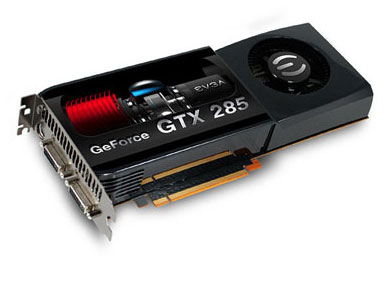
Looks-wise, EVGA GTX SSC isn’t any different from the rest of the GTX 285 pack, but after all – it’s the speed that sets it apart. EVGA GTX 285 SSC runs at 702MHz GPU whereas the reference card (picture below) runs at 648MHz.

In case you didn’t know, GTX 285 is basically a refresh of the GTX 280. The GT200 GPU, used on both cards, has transitioned from 65nm (GTX 280) to 55nm (GTX 285). There’re still 240 shaders, 32 ROPs and the rest of the specs are left unchanged. However, the speeds have been changed, and it resulted in a GTX 285 rename. Since the GPU and the memory got a boost, it’s clear from the start that the GTX 285 is faster than GTX 280.
Compared to GTX 280, the new card is more efficient as it consumes less energy and at the same time offers better performance. All chip and transistor manufacturers strive towards shrinking components, as it results in cooler operation, lower consumption and overall less material needed in manufacturing. Nvidia has, just like ATI, transitioned to the 55nm process, and the logical next step would be 40nm.
The GTX 285/280 packs 1024MB of memory running at 1242 (GTX 285 – effectively 2484MHz) and 1107MHz (GTX 280 – effectively 2214MHz). The following two pictures show the most important characteristics of GTX 280 and GTX 285 cards, and we see that the new reference card’s shaders run at 1476MHz. This, however, is not the case with EVGA’s SSC card as its shaders got a boost and now run at 1584MHz.

The GDDR3 memory with 512bit memory interface is still used. The difference in bandwidth and data processing power is a direct result of overclocking the new 55nm GT200 core.
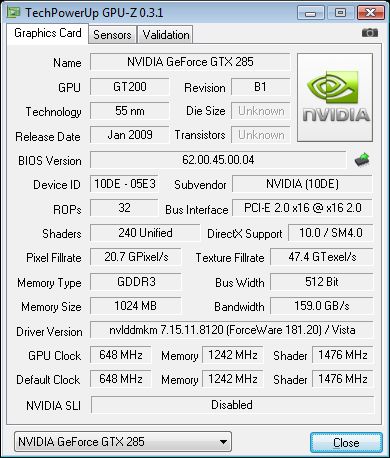
EVGA GTX 285 runs at high 702MHz, but it comes as no surprise, especially knowing that the old GTX could’ve easily been pushed to run at 700MHz. The new chip results in easier overclocking to these speeds at a lower power expense.
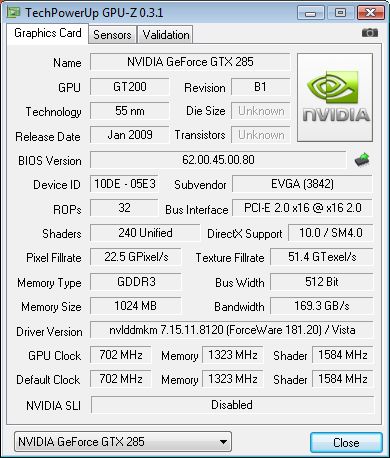
Due to lower power consumption, 53W lower than the old GTX 280 in best case scenario, the card requires only two 6pin power connectors. The GTX 280 is powered via a one 6pin and one 8pin PCI Express power connector.
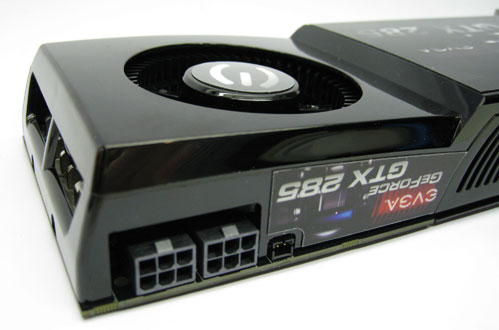
The power connectors are located at the same spot as on the GTX 280. It’s a modern standard for high end cards to require more than 75W that PCI-Express slot provides, and Nvidia says that this card’s maximum TDP is 183W. Next to the power connectors is the SPDIF-In connector that you’ll need in order to bring the sound to the card. In case you want to route both audio and video to your TV via a single HDMI cable, you’ll need to use this. HDMI is supported but you’ll need to use a DVI-to-HDMI dongle.
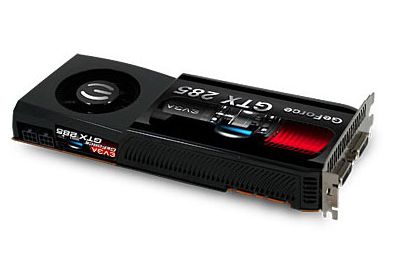
We see that the far end of the card features small vents that let air in for power components in that part of the card. The fan is angled in order to blow air directly towards the GPU. The design is efficient and looks nice.
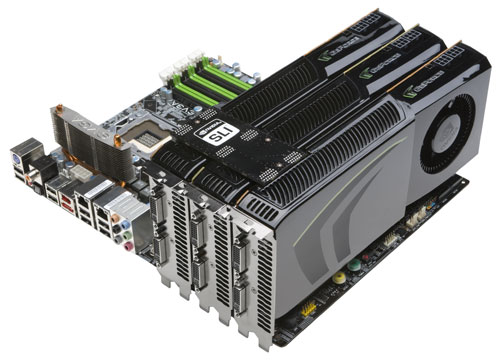
Apart from standard SLI, GTX 280/285 and GTX 260 cards offer three-way SLI support. This means that if your budget supports it, you can treat yourself to three identical cards and treat yourself to some serious three-way gaming goodness. Of course, for such a feat you’ll need a special SLI connector usually provided with motherboards supporting this feature.
The outs feature two dual-link DVI outs and a TV-Out.

A DVI-to-HDMI converter enables you to connect it to HDMI compatible devices.
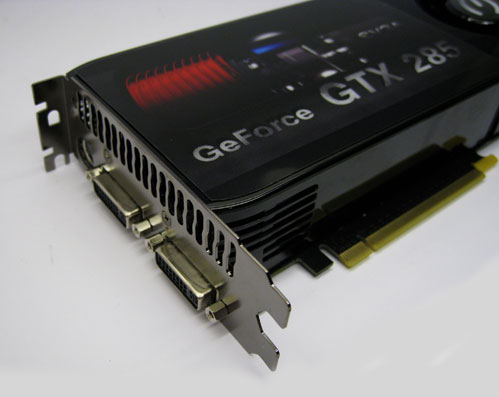
If you’re an early adopter and don’t like waiting for your card to get outdated, EVGA’s 90 day “Step-Up” program lets you swap your existing EVGA card for a new one, after paying the price difference of course.
Unlike the GTX 280, which features 8 memory chips per PCB side, the new GTX 285 has all 16 modules, 64MB each, on the side of the GPU. The card is 10.5’’ long.
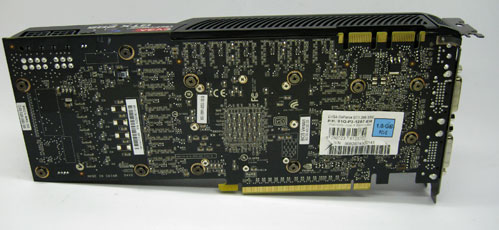
This card also features PureVideo HD (video processing software that puts the GPU to use in HD decoding and playback tasks), CUDA and PhysX but not HybridSLI technology (that combined with an appropriate motherboard lets your card power down during non-demanding tasks, passing the task on to the motherboard’s integrated GPU - more here).
Of CUDA supported apps, we tried out the Badaboom video converter, which really puts the GPU’s muscle to good use while transcoding video formats. CPU-intensive operations that used to go on for hours are now, thanks to the GPU’s power, are down to just minutes. CUDA, or Compute Unified Device Architecture if you will, is an architecture that developers will find quite appealing as programming in high-level programming language C puts some serious parallel processing power at their disposal.
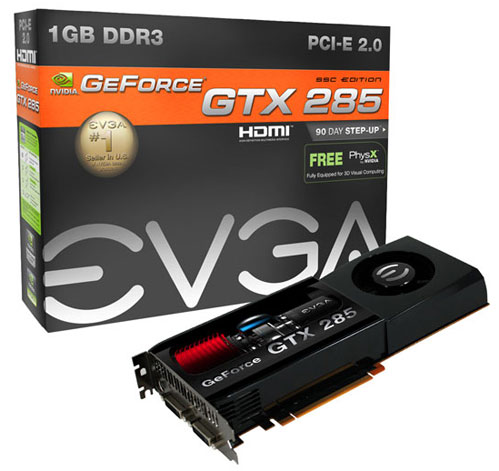
Gaming physics is not an easy task if you want it in realtime, but it’s getting increasingly easier to implement thanks to PhysX technology combined with Nvidia GPU processors. The most popular game supporting this technology is Mirror’s Edge, and you can find it here. EVGA promotes this game and provides a coupon, but only with certain GTX 260 graphics cards.
Testbed
Motherboard: MSI P45D3 Platinum ( Provided by : MSI );
Processor: Intel Core 2 QX9770 Extreme edition na 3.6GHz ( Provided by : Intel );
Memory: Corsair Dominator 12800 7-7-7-24 ( Provided by : Corsair);
HDD: WD VelociRaptor 300G 10,000RPM ( Provided by : SmoothCreation );
Our tables feature results from the GTX 280 card overclocked to GTX 285’s speeds, and we marked them as GTX 280 OC. We reviewed the Inno3D a few of days ago, and you can find more details here.
Futuremark Test
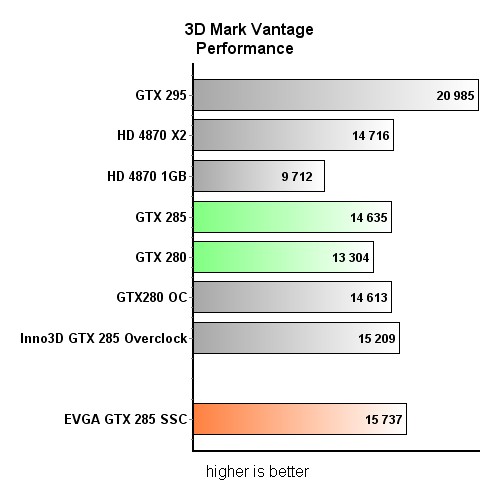
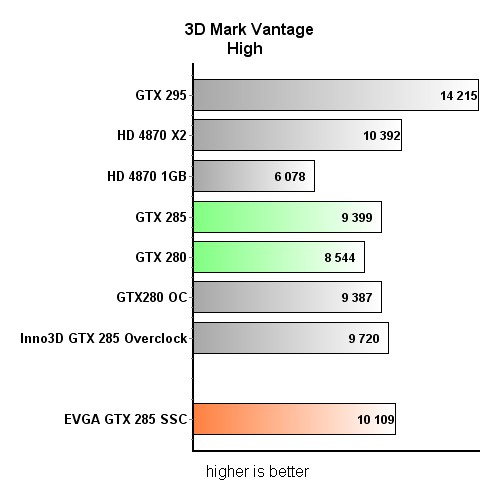
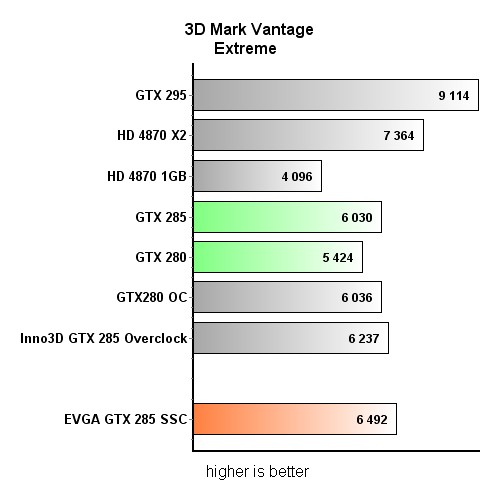
EVGA fares well in Vantage tests and it beats the reference GTX 285 by about 7.5%, whereas the old GTX 280 loses by 20%.

3DMark 06 test shows minimum difference among the GTX 285 cards. Compared to the GTX 280, on the other hand, the results still end up higher by about 4%, whereas EVGA’s SSC card scores 5.3% better results.
Gaming
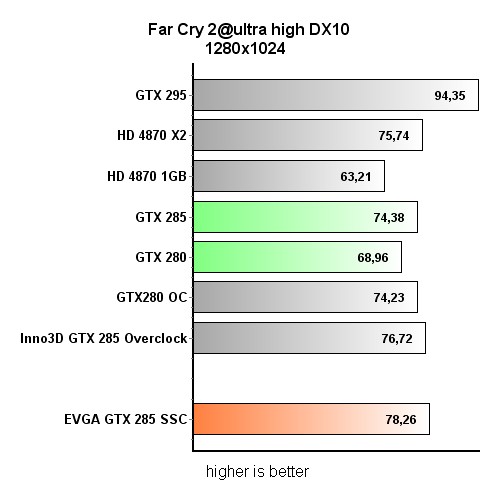
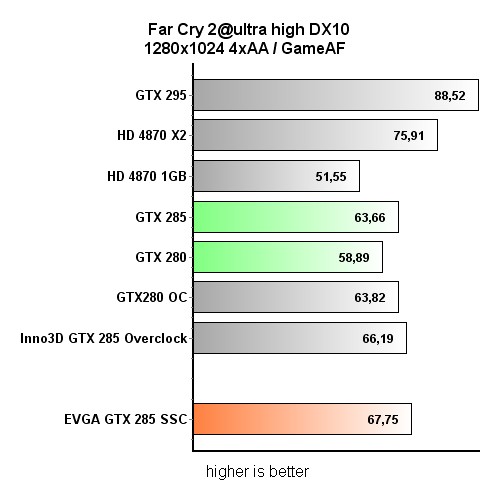
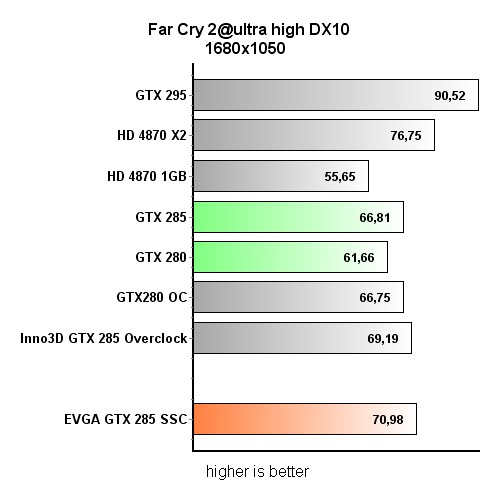
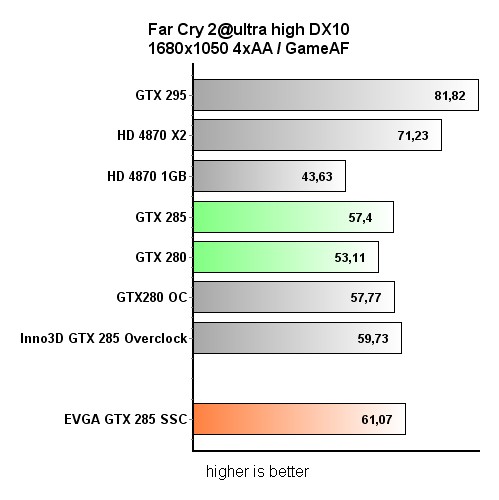
When the filters are on, the GTX 295 and HD 4870 X2 leave the pack and beat the GTX 285 by 42 and 24%, respectively. The same 1680x1050 resolution sees the GTX 285 outperforming the GTX 280 and HD 4870 1GB by 8 and 31%. It runs on par with the overclocked GTX 280, whereas EVGA scores over 60fps at 1680x1050, which clearly shows what this card is capable of.
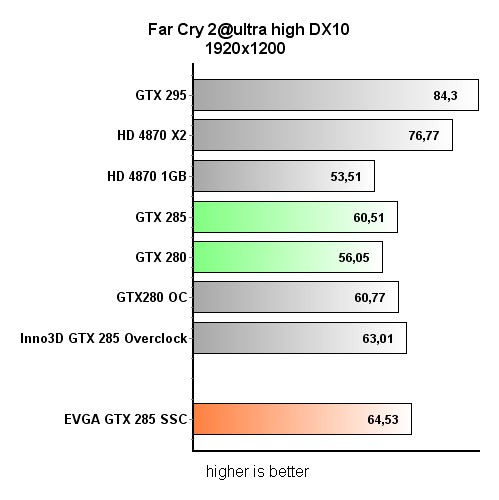
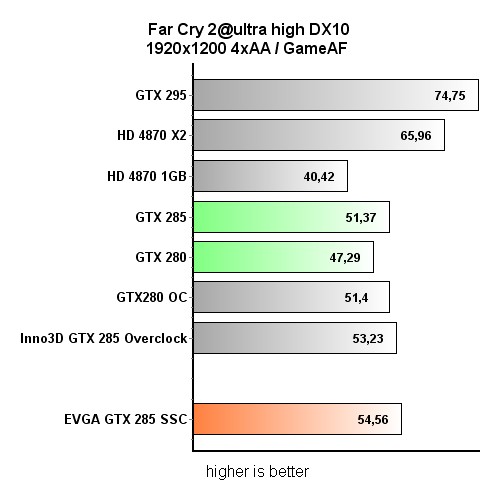
At 1920x1200, GTX 295 and HD 4870 X2 beat the reference GTX 285 by 39 and 27%, respectively. The GTX 285 outperforms the HD 4870 1GB and GTX 280 by 13 and 8%, whereas the overclocked GTX 280 results again end up identical. EVGA is about 6% better than the reference GTX 285 and 15% better than the GTX 280.
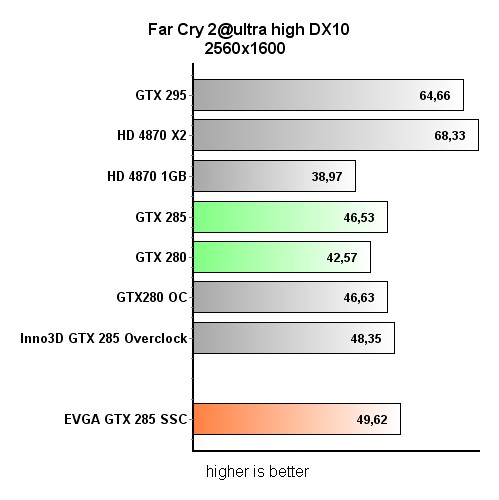

After turning the filters on, the GTX 295 and HD 4870 X2 end up faster than the GTX 285 by 45 and 28%, and the GTX 285 leaves the HD 4870 1GB and GTX 280 behind by 27 and 8%, respectively. The overclocked GTX 280 still runs on level terms with the reference GTX 285.
Here we see EVGA’s GTX 285 SSC trashing the HD 4870 1GB by over 50%, and it outruns the reference GTX 285 by almost 7%.
World in Conflict


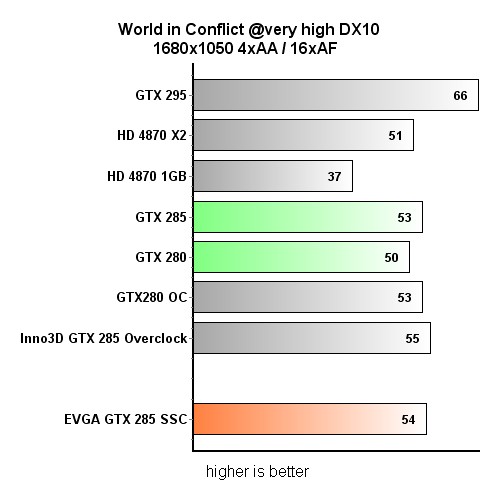
In this game, only at the higher resolutions we see the difference between EVGA’s SSC card at 702MHz and the reference GTX 285 at 648MHz.
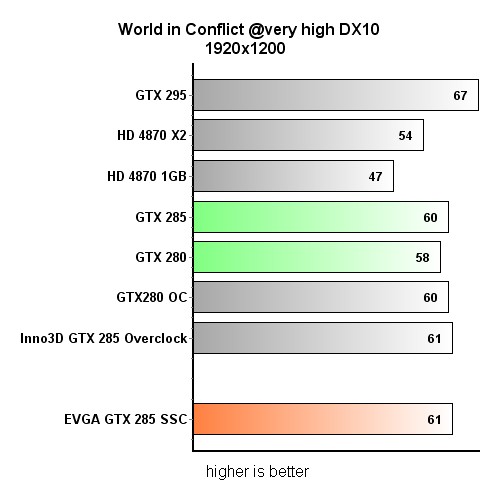
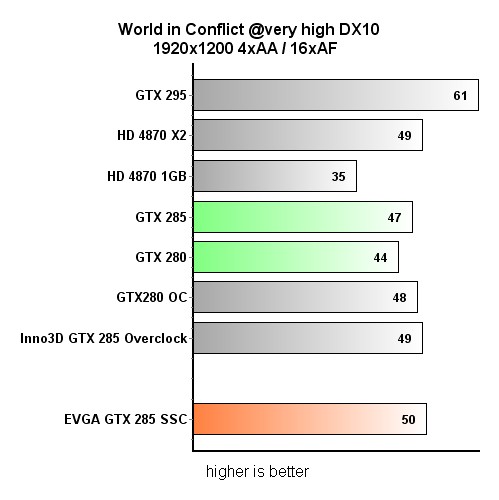
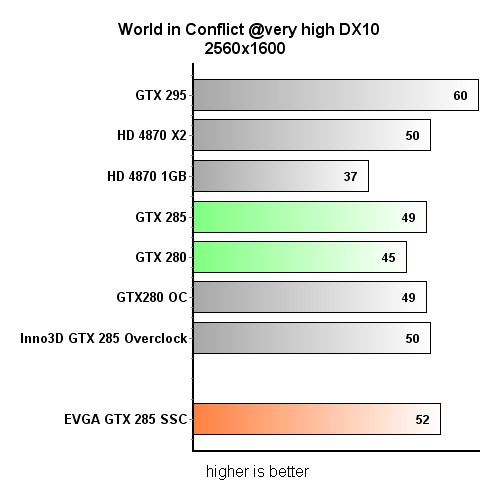
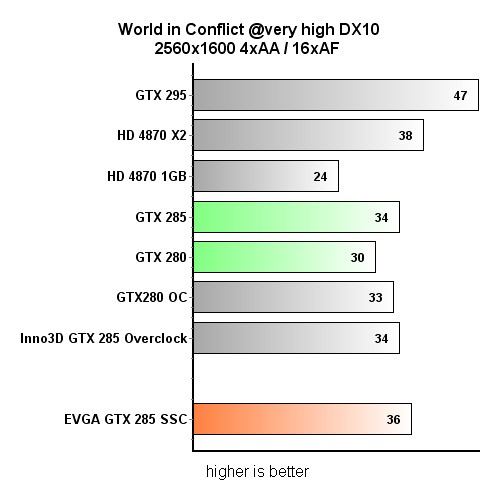
At high resolutions, EVGA GTX 285 SSC card shows that it’s not planning on letting go of its 6% advantage over the reference GTX 285 and almost 20% advantage over the GTX 280.
Overclocking
Like we expected, overclocking the SSC card is a piece of cake. Pushing it up to 740MHz is no tough task, but higher speeds require better GPU cooling. At SSC speeds, the GPU hit 83 degrees Celsius, whereas overclocking it to 740MHz resulted in temperatures of 87 degrees Celsius. Idle operation results in temperatures of 41 degrees Celsius.
Our test rig, containing the GTX 285 SSC, consumes 309W, whereas the reference GTX 285 card brings these figures down to 280W.
In idle mode, EVGA’s card downclocks to 300MHz just like on the reference card, and we measured the consumption of 103W.
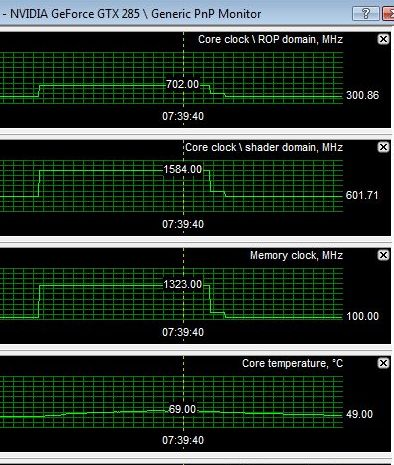
Talking about power consumption, EVGA’s GTX 285 SSC is far more efficient than the GTX 280, since it consumes 10-15W less while operating at much higher clocks.
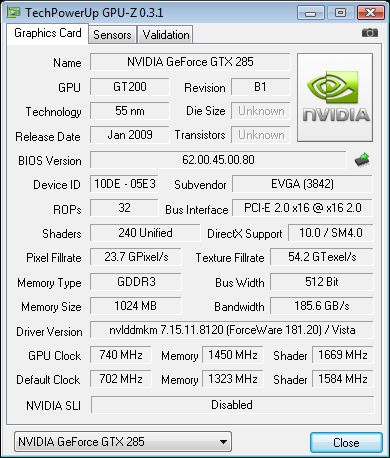
The following tables have OC suffix next to EVGA’s GTX 285 SSC, meaning that we further overclocked it.
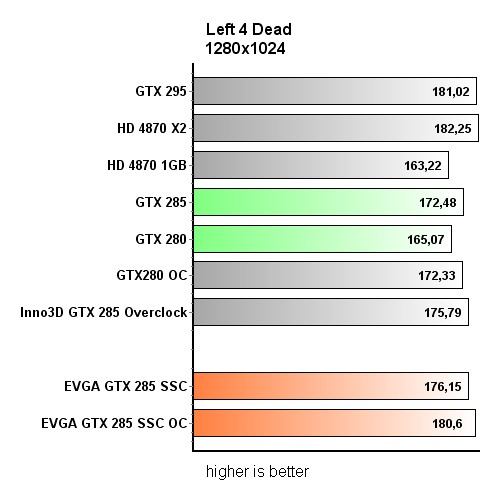

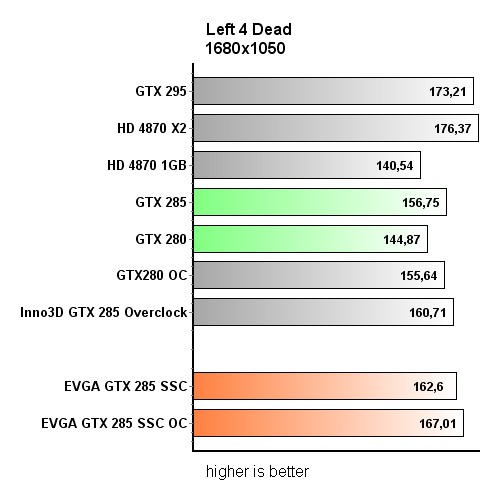
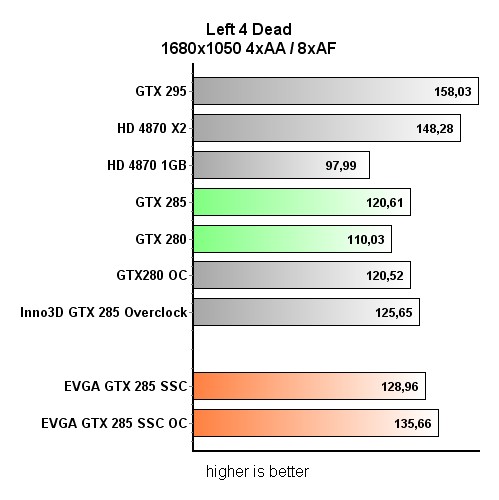
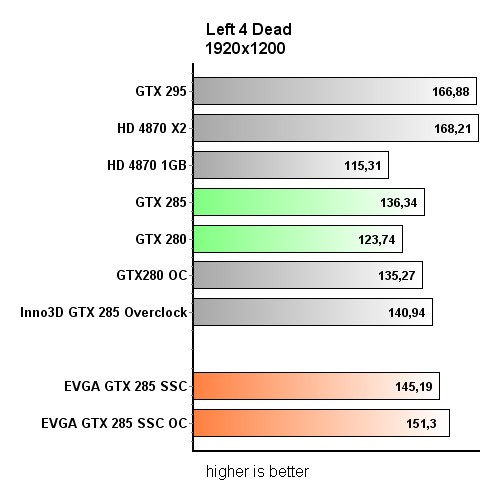
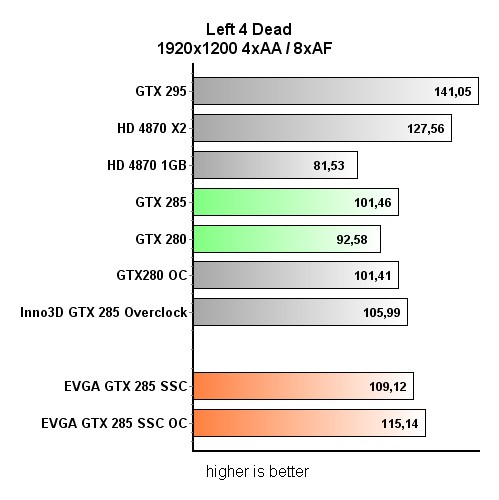
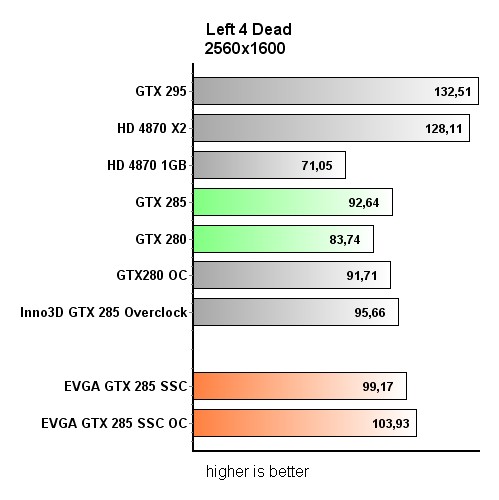
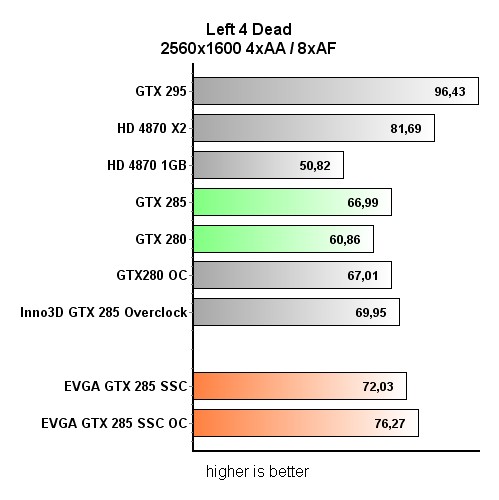
An overclock of 5.4% helped us to about 6% better results and the advantage over the reference GTX 285 jumped to 25%.
Conclusion
The new GTX 280 is called the GTX 285. The GT200 graphics processor is now built in 55nm, which led to significant improvements on the fields of consumption and higher clock performance. GT200 basically didn’t change during the transition from 65nm (GTX280) to 55nm (GTX 285). However, the shrink enabled higher reference speeds and while the GTX 280 runs at 602MHz, the GTX 285’s reference speed is 648MHz.
EVGA jumped onto the overclocking wagon with their Super Super Clocked GTX 285 card, and the name suggests that this card received a significant boost. GTX 285 SSC’s GPU runs at 702MHz, the memory at 1323MHz (2646MHz effectively) and the shaders at 1584MHz.
The GTX 285 is one of the best single-chip Geforce cards, and only the recently announced EVGA GTX 285 FTW has enough muscle to beat it. EVGA GTX 285 SSC packs 240 stream processors, enabling excellent gaming as well as CUDA-supported application performance, which uses the GPU to process data. PhysX is also a part of the deal that you get with Nvidia Geforce 8th and 9th generation cards.
Overclocking resulted in EVGA having the upper hand compared to the reference GTX 285, but the difference is also notable when compared to the GTX 280, which loses to the SSC by as much as 20%. Although this card features great gaming and multimedia potential, the GTX 280 owners will find the main reason for the upgrade to be lower consumption.
The card now needs two 6-pin power connectors (unlike 1x6pin + 1x8pin on GTX280) and has a TDP of 183W. In the best case scenario, it will consume up to 53W less than the GTX 280, whose TDP is 236W.
The only downside is the €50 price difference between the GTX 280 and GTX 285 cards. EVGA GTX 285 SSC will provide pleasant gaming at all resolutions, but it will set you back about €400. On the other hand, if you want the fastest single-GPU card Nvidia can offer, then the GTX 285 SSC is the card you’re looking for.

